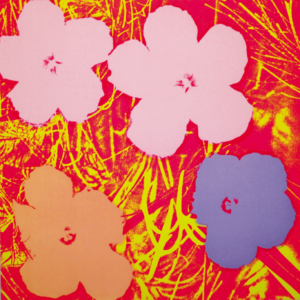
Andy Warhol (American, 1928-1987), Flowers, 1970, screenprint on paper, extra, out of the edition. Designated for research and education purposes only. 36 x 36 in., Hofstra University Museum Collections, gift of The Andy Warhol Foundation for the Visual Arts Inc., HU2013.14
© The Andy Warhol Foundation for the Visual Arts Inc.
By Samantha Storms
Arts & Entertainment Assistant Editor
Showcased on the walls of the Hofstra University Museum in glass cases that seem to struggle to contain the sheer magnitude of their vibrancy are the works of Andy Warhol, the Pittsburgh native who would become one of the most legendary pop artists of all time. Each photograph, with slabs of clashing colors and uncomfortable positioning, turned the mundane into the unusual – it turned the ordinary into the spectacular.
Through his daring use of repetition, color and contrast, Warhol thoroughly changed the way in which his viewers are made to perceive the cultural influences that permeate every day of their lives. His ability to turn something as simple as the Campbell’s soup can into an icon is a testament to his ability to manipulate the lens with which viewers identify and connect with the art in front of them.
One such work entitled “Veronica Hearst,” a series of nine photographs of the socialite subject, highlighted not only her beauty through the use of flawless white face makeup, contrasting black liner and cherry red lips, but the materialism with which viewers identify her by and associate her with. The similarity between Hearst’s poses – from the way she tipped her head slightly forward or offered the camera a slight smile in every photograph – emphasizes Warhol’s understanding of the viewer’s fascination with idealism, status and couture.
Similarly, Warhol’s work “Brooklyn Bridge” explored the ability of artistic juxtaposition to highlight the effect that the passage of time has upon one of the most recognizable structures in America. The clashing colors that Warhol incorporated into the piece further emphasize the differences between the two images of the bridge, separating each line and curve from the background and bringing them forward to meet the viewer’s eye. Similar techniques can be found in works such as “Queen Ntombi Twala of Swaziland” and “Sunset,” two images that serve to highlight the ability of contrast to draw the viewer in and see the person or object for more than with which it would typically be associated.
His fascination with celebrity culture and popular icons allowed Warhol to present to his viewers an opportunity to understand the world around them in an entirely new, exciting and unfamiliar way. Whether his art explored the alien elegance of high-status women, the juxtaposition of the vintage and the modern or the connection amongst items seemingly completely unrelated, Warhol was able to use his eye for pop art to capture the world’s interest for years to come.
